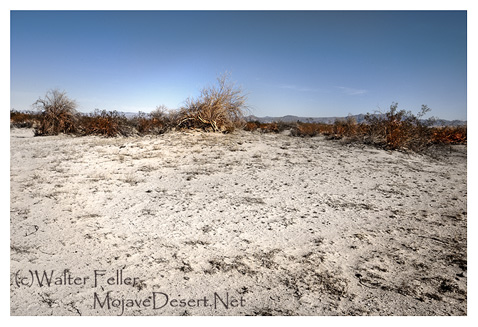Descending the Mojave River

Descending the
Mojave River
to the present site of Victorville,
the searchers soon found the evidence they needed; the remains of four mission Indians from San Gabriel, three from San Fernando, and
some pagan Indians, all murdered by the Mohave. Funeral services were held with ceremonies and processions before they were buried
beneath a large cross.
Moraga
and
Fray Joaquin Pasqual Nuez
renamed the place Las Animas Benditas de Atongaibit, (12) and the
Mojave River was renamed Rio de las Animas (River of the Souls or Spirits).
They followed the trail downriver until they arrived at what they called San Joaquin y Santa Ana (this was either
Afton Canyon
or the present
Camp Cady
site). In order to overtake the
Mohave,
Moraga and a select fourteen rode ahead, traveling all day and part of the night until their horses could go no further. They retreated -
defeated not by the Mohave but by the desert trail where the Mojave River sinks into the sand. They arrived back in San Gabriel on
December 14, 1819. (13)
The Mohave Indians continued the trade but generally kept away from the missions and the Indians loyal to Spain (loyal to Mexico
after 1821). They preferred to trade with the renegade or runaway Indians. The Mojave trail became a haven for the fugitives from
civilization. Many of the {M}ission Indians were captured by the Mohave, and evidently these captives preferred the treatment of
the Mohave to the vicissitudes of the mission-presidio-ranch culture of California.
The first American who traversed the Mojave Indian Trail gave evidence as to how the
Indians were treated at San Gabriel. Jedediah Smith
and his trappers entered the domain of the Mohave in 1826 and were hospitably treated. The exhausted trappers remained
in the Indian village for two weeks, resting and buying melons, corn, beans, pumpkins, and a little wheat. They even purchased some horses
the runaway Indians (who spoke good Spanish) had stolen from the Mexicans in California. Smith obtained two Indians to guide him over the
Mojave Desert. Even though the surprised Mexican authorities treated Smith and his rugged trappers with suspicion, the padres at San Gabriel
welcomed the Americans with "good old whiskey", wine, and "sigars" and feasting. The next day they had tea, bread and cheese, gin and water,
and then dinner. The two Indian guides were treated in another way, however - they were locked up in the stockade. (14)
< PREVIOUS - Indian Slave Trade - NEXT >